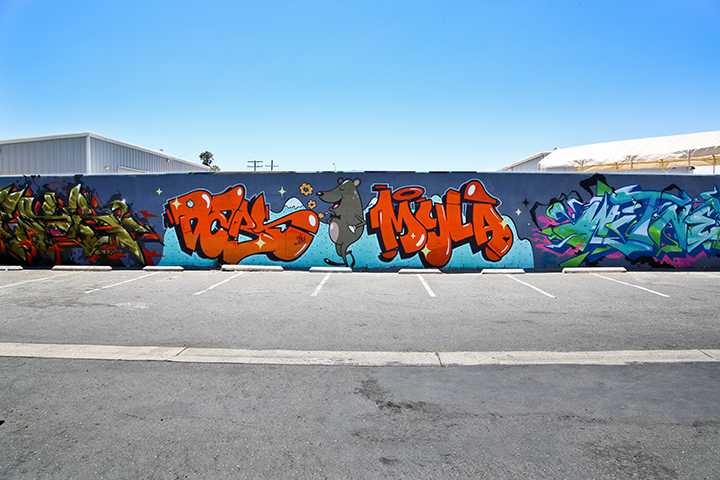
Street art’s small but loyal following in Orange County makes a case for its importance in the region.
By Linda Domingo
Born from scrawling in alleyways, under overpasses, across billboards and on the sides of train cars, street art is a category of expression that conjures up mixed reactions ranging from passionate acclaim to awe, shock, disgust and outright fear. It’s gaining fans across the globe though, as cities have embraced street art festivals such as Honolulu’s Pow Wow Hawaii and public art projects like Miami’s Wynwood Walls. Artists have harnessed the power of the Internet to promote themselves, and mainstream clothing companies have slapped urban-inspired artworks on T-shirts, hats and shoes. In 2010, elusive U.K.-based artist Banksy exposed an entirely new audience to it through the film “Exit Through the Gift Shop.”
But the colorful walls and creative characters of the street art subculture remain almost nonexistent in Orange County. Confined to sparse walls and even sparser galleries, there is street art here but—like the days before social media—to find it, you must know where to look.
Prime Coat
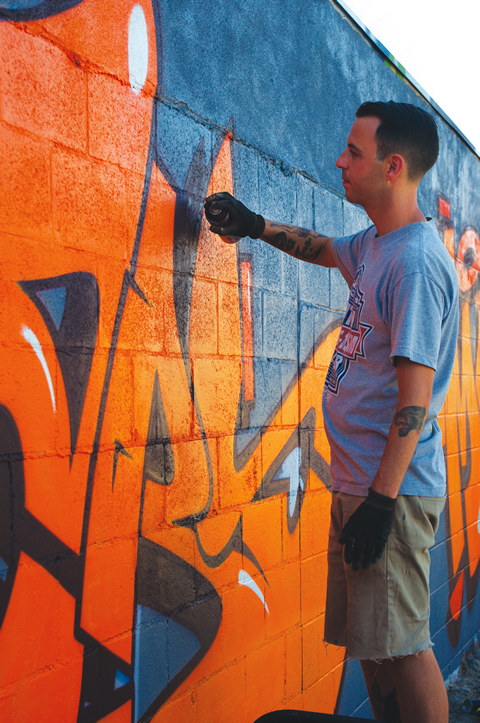
Street art’s roots trace back to illegal graffiti, the act of writing, scratching or spraying letters—most often a name—onto surfaces in public spaces. The illicit activity gained traction in the 1980s and 1990s, and continues to carry a heavy stigma as some gangs utilized it as a means to signify territory or send messages. The shared history of the terms “street art” and “graffiti” have caused the general public to define them synonymously; however, artists and those who are involved with either or both are quick to start a dialogue about their differences.
“Street art owes a lot to graffiti … but they have really become distinct categories,” says Newport resident James Daichendt, associate dean at the school of visual and performing arts at Azusa Pacific University. James also researched and wrote about the topic in his books “Stay Up! Los Angeles Street Art” (2012) and “Shepard Fairey Inc.: Artist/Professional/Vandal” (2014).
He explains that graffiti is more commonly understood as letter-based, and is usually a person’s name. “As you get closer into something called ‘street art,’ it rubs up against the professional art world,” he says.
Street art is understood as more character-based, and the imagery is often more important than the name, if there is a name present at all. More simply put, it’s art that has been placed outside where the public can view it.
“Street art is a loose term with a definition that has only recently been addressed,” explains an artist who identifies himself as Bert, and is known for his uncommissioned, surf-inspired works in coastal cities including Newport and Huntington Beach. “Within ‘street art’ you find stickers, wheat pastes, stencils and other aesthetics more related to graphic design.”
James also clarifies that the terms “graffiti” and “street art” don’t always fall into the category of vandalism. Because street art has gained such a large following in recent years, many street art pieces are legal, commissioned and seen as beautifying the cityscape. “Many of those artists in the street art genre have professional art backgrounds,” he says. “To say [all street art] is illegal would be throwing the baby out with the bathwater.”
Painting a New Picture
Street art’s controversial history has caused it to carry negative connotations, but there are artists, gallery owners and other supporters who are working to educate the general public about its value and place in Orange County, despite the region’s natural aversion to the movement. In 2005, the Orange County Museum of Art (OCMA) hosted “Beautiful Losers: Contemporary Art and Street Culture,” a traveling exhibition that highlighted artworks influenced by skateboarding, graffiti and punk lifestyles.
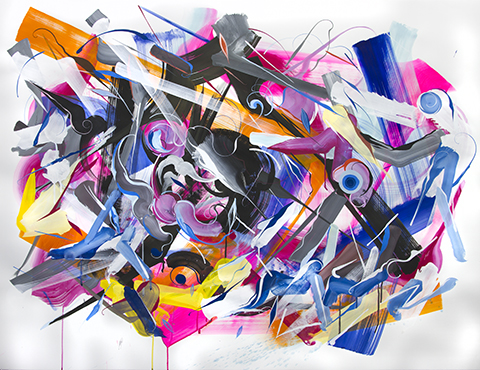
“That was massive,” describes Dana “DJ” Jazayeri, co-owner and curator of Santa Ana’s new Marcas Contemporary Art gallery, as well as owner of As Issued Art + Design Bookstore at The Lab in Costa Mesa. The traveling exhibit brought artists who were household names in the street art world to infiltrate the conservative Orange curtain.
“Museum institutions are beginning to embrace [street art] because it’s what brings money to them—because it’s what’s popular in society, to people that would be patrons,” he adds.
While the OCMA exhibit was popular, Orange County hasn’t seen much growth in the number of street artworks or museum shows that highlight street artists. The recent openings of Marcas and Costa Mesa’s Dax Gallery are, however, a glimmer of hope for those who support the movement. Although they differ in approach, both local galleries are showcasing the work of young talent who can be categorized as street artists.
“The best way to redefine our contemporary would be street art,” says DJ, who has collected pieces by well-known street artists—in addition to other works—since he was a teenager. “It’s the only thing that is such an out-there subgroup that doesn’t fall into pop surreal or lowbrow or hyperrealism or figurative works. … It’s its own defined style.”
“Street art, to me, speaks to a younger community,” adds Newport resident and Dax Gallery owner Alex Amador. “I believe there is a need for this type of art around here.”
Dax has featured the likes of street artists including Risk, Meggs and Greg Mike, all whom are not OC natives. “A lot of Orange County [artists], when they get a little steam behind them, they move to LA,” Alex explains. “That’s the sad thing—because there’s not really a support system here for them. There’s not a hub to brainstorm or be influenced by.”
“A very good handful of the most well-known, well-respected … street artists [are from] Irvine, Santa Ana, Costa Mesa [and] Huntington Beach,” DJ adds. “Why did they leave? Because they were stifled.”
Artists in Residence
Some street artists do remain local, although they seem to agree that the region hasn’t been friendly to their work.
“I’m just negative on the whole scene here,” says Mark Paul Deren, a street artist and designer who goes by Madsteez.
Although his studio is in Costa Mesa, he doesn’t do much painting in the area. The artist dabbled in illegal street art in the past, but explains that he’s given it up “just based on not wanting to go to jail.” Besides, he’s been brought on by big brands such as Boost Mobile, Nike and Mini Cooper for his creative talents, in addition to painting commissioned murals.
“There’s a mural I did in Huntington,” he says of the colorful beach piece that resides off of Main Street between Pacific Coast Highway and Walnut Avenue. “It was eight months of city planning. … I had to go in front of the board once every two weeks and present what I was doing. There’s an 85-year-old lady with some 60-year-old guy … who don’t know what’s going on with youth culture right now. [Cities] need to change and be accepting to art. They don’t get it.”
Another artist, who goes by the name Tyke Witnes, also resides in Orange County and echoes Mark’s sentiments. “There’s only a handful of writers [here]—you can count them on your fingers and name them,” he says.
Having been a part of the graffiti and street art scenes since the late 1980s, Tyke has since begun to paint on canvas in addition to continuing mural work and creating designs for clothing companies. Many activewear brands based in Orange County, such as Hurley, LRG and RVCA, have embraced the work of street artists. The artworks by Tyke and his contemporaries, however, have been somewhat contained to clothing and the companies’ headquarters, with the exception of a couple murals done in collaboration with street art-friendly businesses like Wahoo’s.
Color Theory
The few artists, gallery owners, businesses and patrons that support street art in Orange County remain passionate—if somewhat pessimistic—about educating the public and opening eyes to this new movement. In addition to suggesting the opening of city-controlled, legal street art walls, many have suggested street art festivals similar to those held in Hawaii; Miami; Taiwan; Melbourne, Australia; and Lima, Peru.
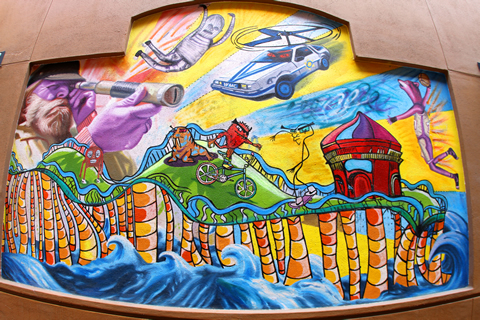
In the early 1990s, Huntington Beach pioneered a program in which the city issued permits for people to paint along a seawall. One year later, the program was disbanded and the walls were painted over due to police and resident complaints that it encouraged illegal graffiti in nearby neighborhoods—despite arguments from proponents, including Gerald Chapman, then-director of the Huntington Beach Art Center Foundation, that there was no substantial evidence of this.
“In Orange County, I will paint any wall that I can get permission to paint on,” Tyke says. He recently painted a wall behind Mesa Art & Framing in Costa Mesa along with Ewok, another well-known OC-based artist, and Dabs and Myla, an Australian artist couple world-renowned in the street art realm. They were given permission by Frank Gutierrez, the owner of Mesa Art & Framing, and contributed three large pieces for free. As colorful as the artworks are, they remain somewhat hidden behind the building, away from main street visibility.
Frank allows Tyke and his artist friends to paint the wall, buff out the works and paint again, usually once a year. As the chairman of the City of Costa Mesa Cultural Arts Committee, Frank is a champion of fostering a creative environment in the city, explaining that street art is one of the most accessible forms of art.
“It’s just as good as fine art,” he says. “It’s done with spray cans; that’s just the medium. But look at the imagery and the refinement of the imagery.”
“[Art] has become more conceptual and difficult to understand,” James continues. “Street art, and a lot of urban art [coming from] skate culture, surf culture—it’s all easily accessible. People can engage with it right away.”
Although he allows street artists to paint his walls, Frank also adds that it’s important to control what’s put on the streets, the reason behind city committees needing to review pieces before they are put up on walls where the public can see them.
This process, however, is where things can get difficult for the people that are pushing for more street art. “When you tell them ‘street art’ … they picture [illegal] graffiti,” Alex says, adding that a mural of Pablo Picasso that adorns the side of Dax Gallery took months to approve.

“The minute you say, ‘street art,’ they’re like, ‘nope,’ ” DJ echoes of the approval process. “What people don’t think about is that street art, or any mural, can deter [illegal] graffiti.”
In addition to opening Marcas, DJ is working on bringing mural projects to the county as a form of exposure for artists and the gallery. He explains that when an artist, especially a well-known one, paints a wall, other artists will respect the wall and leave it alone.
“No one else will try to go over it because you don’t want to cause trouble,” Tyke adds.
Moreover, the gallery owners and artists agree that the large artworks can attract business. “I watched people stop and take photos all day of my art,” Bert says of a piece he painted on the side of a shaved ice shop. “I am not sure if this business owner ever deemed it art, but he sold a [lot] of shaved ice because of it.”
Most importantly, advocates explain that the acceptance of a wider range of art forms will benefit the Orange County community as a whole, facilitating a more creative atmosphere.
“LA really turned into an art hub because they embraced that urban aspect,” DJ says. “We need to control it but allow it to happen. … Museums that have embraced it are doing better than other museums that haven’t.”
“To have creativity and develop it, you have to have the surroundings,” Mark states. “Creativity is fostered in colleges and programs of art, businesses of art like galleries. But in reality, the simplest and easiest form is the underground art, where somebody with nothing can come up with something that’s creative and cool.”


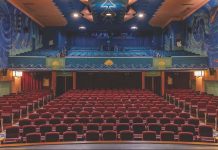

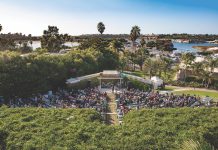
Excellent bloig you have here but I was curious about if you knew
of any community forums that cover the same topics discussed in this article?
I’d really love to be a part of online community where I can get feedback from other
knowledgeable individuals that share the same interest.
If you have any recommendations, please let me know. Kudos!